Leadership and Ethics: Reflecting on My Leadership Experience
VerifiedAdded on 2022/10/19
|8
|2908
|179
Essay
AI Summary
This essay delves into the author's leadership experience within an organization, focusing on the challenges of employee turnover due to work-related stress. The author, acting as a manager, implemented a leadership approach by engaging with employees, understanding their problems, and implementing solutions like employee engagement programs and recognition sessions to boost morale and reduce turnover. The essay applies transformational and situational leadership theories to analyze the experience, highlighting the use of positional power and managerial tactics. Additionally, it incorporates Maslow's Hierarchy of Needs and Herzberg's Two-Factor Theory to explain motivation strategies. The essay emphasizes the importance of ethical leadership, suggesting characteristics such as fairness, transparency, and adherence to ethical principles, and concludes with recommendations for future situations, stressing the need for an ethical approach and adherence to organizational rules. The essay provides a detailed analysis of leadership, ethics, and their practical applications in the workplace.
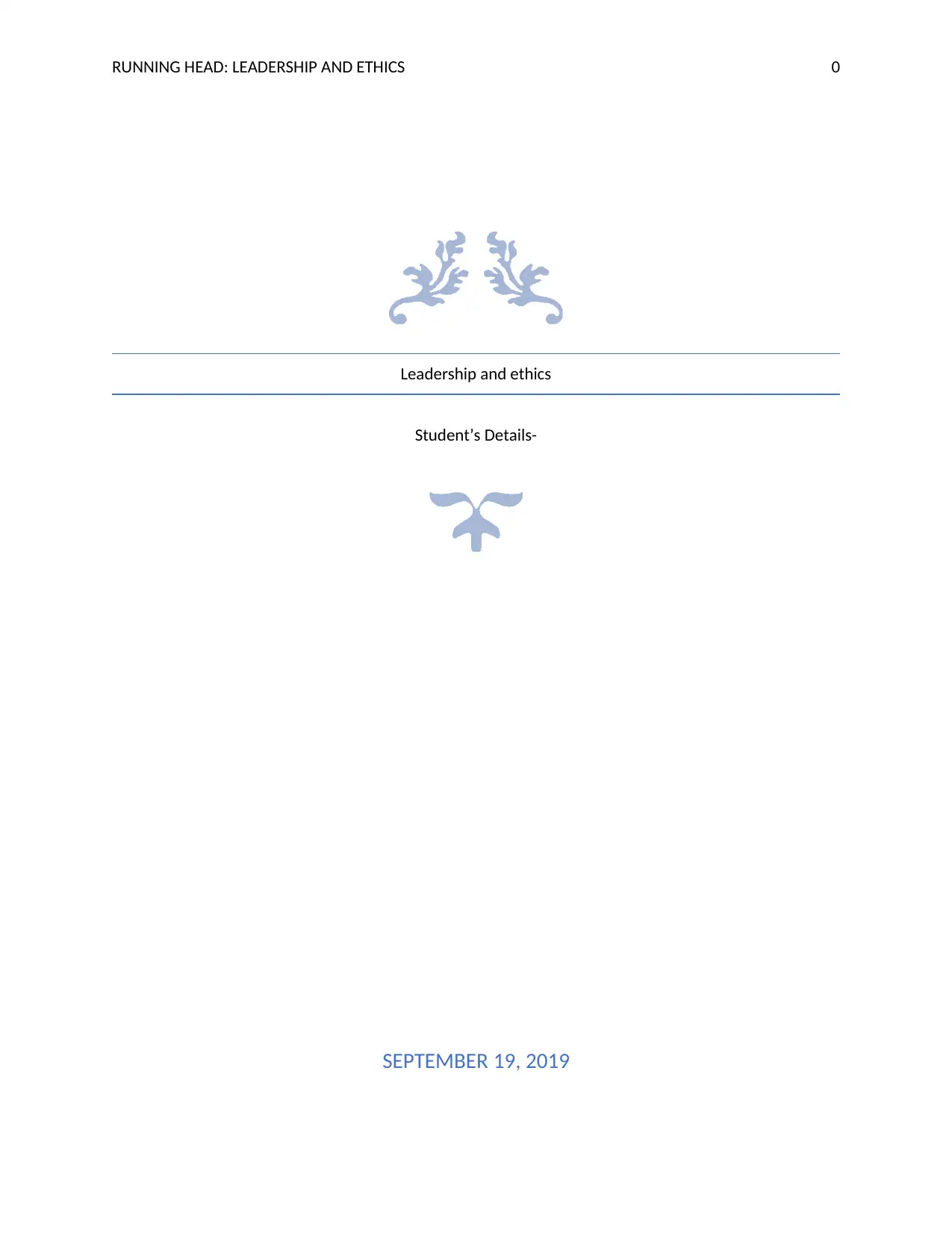
RUNNING HEAD: LEADERSHIP AND ETHICS 0
Leadership and ethics
Student’s Details-
SEPTEMBER 19, 2019
Leadership and ethics
Student’s Details-
SEPTEMBER 19, 2019
Paraphrase This Document
Need a fresh take? Get an instant paraphrase of this document with our AI Paraphraser

RUNNING HEAD: LEADERSHIP AND ETHICS 1
Leadership and Ethics
Leadership is regarded as the process or action of influencing and leading a group of
people towards the attainment of the goals. Leadership is exercised by a leader who has the
capability to influence a majority of people and also has the required personality to provide
guidance and support to employees within the organization (Western, 2019). Ethics are the moral
principles that define the right behavior of the leader. A leader is supposed to be ethical in all the
decisions and also the conduct in order to provide better messages to the organization and its
people (Fransen, Vanbeselaere, De Cuyper, Vande Broek, & Boen, 2018). Here, the essay
discusses my leadership experience at the workplace where I had taken a leadership approach for
the betterment of my organization. In the foregoing analysis of my experience, I have applied
various theories of motivation and also leadership on my experience for better analysis of the
situation. Further, in this essay, I have explained the problems related to my experience and also
elaborated the tactics that I have used for coping with the situation. Also, I have reflected my
experience in terms of ethical or good leadership which is crucial for the organization along with
the recommendations for the future situation.
While working into the organization on the position of a manager, I noticed that the
employees of my company were leaving the organization very frequently one after the other. In
the discussion with the employees, I analyzed that the major cause for the employee turnover
was the increasing stress of work. Due to this, the employees were demotivated and often leaving
the organization. The condition also led to the decreased productivity of the company. Therefore,
for dealing with this situation, I had taken a leadership approach to deal with the situation. It can
be noted that leadership is not always giving direction and being a boss, it means understanding
the problems of the employees and solve them on the priority basis (Joseph, Dhanani, Shen,
McHugh, & McCord, 2015).
Therefore, I started by having a healthy conversation with every employee in order to
understand their problems and provided them guidance to cope with the situation. In my
leadership journey, I also organized employee engagement programs and recreational activities
within the workplace for the purpose of removal of stress of the employees. Also, I had arranged
a rewards and recognition session for praising the talent of the employees. Thus, this approach
Leadership and Ethics
Leadership is regarded as the process or action of influencing and leading a group of
people towards the attainment of the goals. Leadership is exercised by a leader who has the
capability to influence a majority of people and also has the required personality to provide
guidance and support to employees within the organization (Western, 2019). Ethics are the moral
principles that define the right behavior of the leader. A leader is supposed to be ethical in all the
decisions and also the conduct in order to provide better messages to the organization and its
people (Fransen, Vanbeselaere, De Cuyper, Vande Broek, & Boen, 2018). Here, the essay
discusses my leadership experience at the workplace where I had taken a leadership approach for
the betterment of my organization. In the foregoing analysis of my experience, I have applied
various theories of motivation and also leadership on my experience for better analysis of the
situation. Further, in this essay, I have explained the problems related to my experience and also
elaborated the tactics that I have used for coping with the situation. Also, I have reflected my
experience in terms of ethical or good leadership which is crucial for the organization along with
the recommendations for the future situation.
While working into the organization on the position of a manager, I noticed that the
employees of my company were leaving the organization very frequently one after the other. In
the discussion with the employees, I analyzed that the major cause for the employee turnover
was the increasing stress of work. Due to this, the employees were demotivated and often leaving
the organization. The condition also led to the decreased productivity of the company. Therefore,
for dealing with this situation, I had taken a leadership approach to deal with the situation. It can
be noted that leadership is not always giving direction and being a boss, it means understanding
the problems of the employees and solve them on the priority basis (Joseph, Dhanani, Shen,
McHugh, & McCord, 2015).
Therefore, I started by having a healthy conversation with every employee in order to
understand their problems and provided them guidance to cope with the situation. In my
leadership journey, I also organized employee engagement programs and recreational activities
within the workplace for the purpose of removal of stress of the employees. Also, I had arranged
a rewards and recognition session for praising the talent of the employees. Thus, this approach
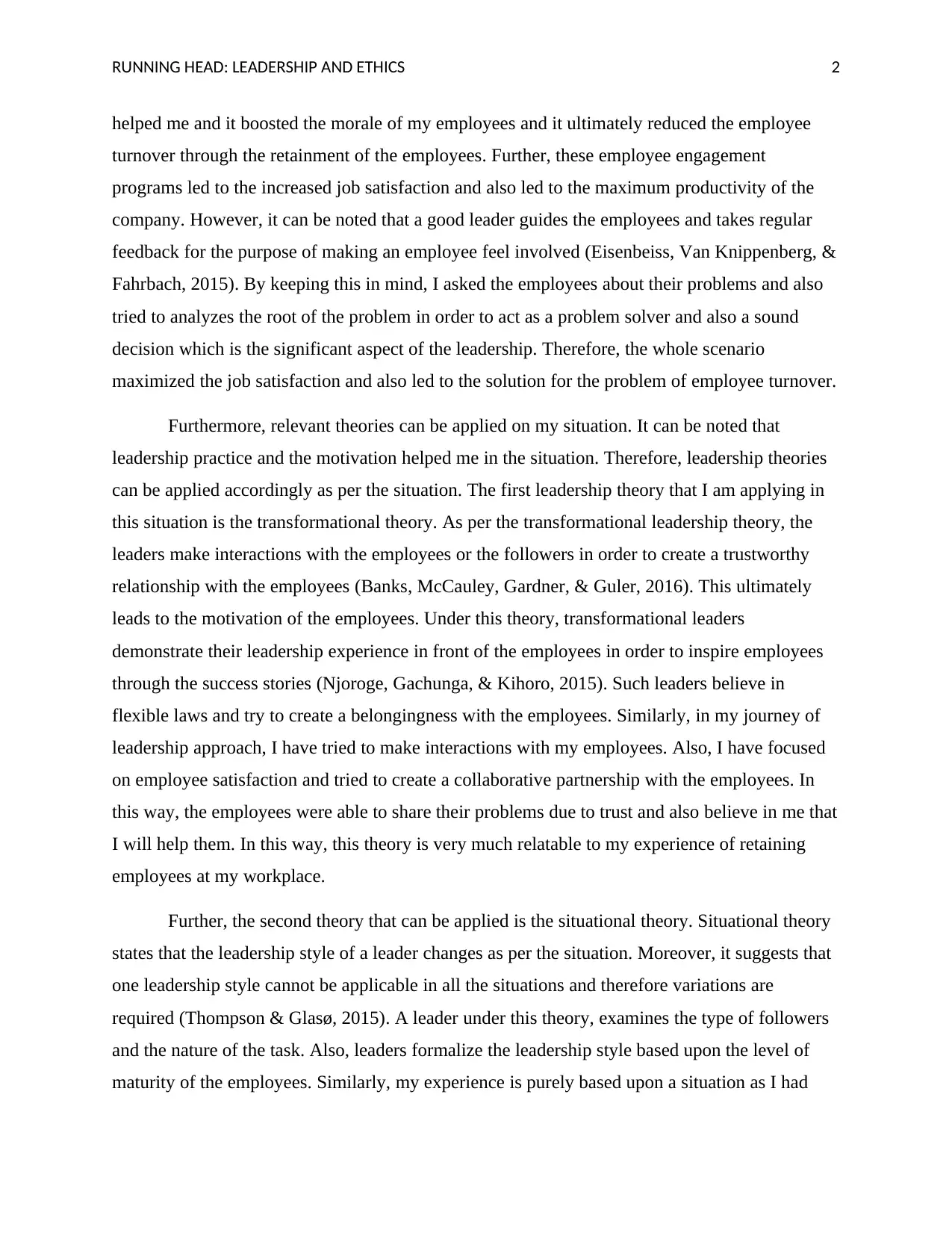
RUNNING HEAD: LEADERSHIP AND ETHICS 2
helped me and it boosted the morale of my employees and it ultimately reduced the employee
turnover through the retainment of the employees. Further, these employee engagement
programs led to the increased job satisfaction and also led to the maximum productivity of the
company. However, it can be noted that a good leader guides the employees and takes regular
feedback for the purpose of making an employee feel involved (Eisenbeiss, Van Knippenberg, &
Fahrbach, 2015). By keeping this in mind, I asked the employees about their problems and also
tried to analyzes the root of the problem in order to act as a problem solver and also a sound
decision which is the significant aspect of the leadership. Therefore, the whole scenario
maximized the job satisfaction and also led to the solution for the problem of employee turnover.
Furthermore, relevant theories can be applied on my situation. It can be noted that
leadership practice and the motivation helped me in the situation. Therefore, leadership theories
can be applied accordingly as per the situation. The first leadership theory that I am applying in
this situation is the transformational theory. As per the transformational leadership theory, the
leaders make interactions with the employees or the followers in order to create a trustworthy
relationship with the employees (Banks, McCauley, Gardner, & Guler, 2016). This ultimately
leads to the motivation of the employees. Under this theory, transformational leaders
demonstrate their leadership experience in front of the employees in order to inspire employees
through the success stories (Njoroge, Gachunga, & Kihoro, 2015). Such leaders believe in
flexible laws and try to create a belongingness with the employees. Similarly, in my journey of
leadership approach, I have tried to make interactions with my employees. Also, I have focused
on employee satisfaction and tried to create a collaborative partnership with the employees. In
this way, the employees were able to share their problems due to trust and also believe in me that
I will help them. In this way, this theory is very much relatable to my experience of retaining
employees at my workplace.
Further, the second theory that can be applied is the situational theory. Situational theory
states that the leadership style of a leader changes as per the situation. Moreover, it suggests that
one leadership style cannot be applicable in all the situations and therefore variations are
required (Thompson & Glasø, 2015). A leader under this theory, examines the type of followers
and the nature of the task. Also, leaders formalize the leadership style based upon the level of
maturity of the employees. Similarly, my experience is purely based upon a situation as I had
helped me and it boosted the morale of my employees and it ultimately reduced the employee
turnover through the retainment of the employees. Further, these employee engagement
programs led to the increased job satisfaction and also led to the maximum productivity of the
company. However, it can be noted that a good leader guides the employees and takes regular
feedback for the purpose of making an employee feel involved (Eisenbeiss, Van Knippenberg, &
Fahrbach, 2015). By keeping this in mind, I asked the employees about their problems and also
tried to analyzes the root of the problem in order to act as a problem solver and also a sound
decision which is the significant aspect of the leadership. Therefore, the whole scenario
maximized the job satisfaction and also led to the solution for the problem of employee turnover.
Furthermore, relevant theories can be applied on my situation. It can be noted that
leadership practice and the motivation helped me in the situation. Therefore, leadership theories
can be applied accordingly as per the situation. The first leadership theory that I am applying in
this situation is the transformational theory. As per the transformational leadership theory, the
leaders make interactions with the employees or the followers in order to create a trustworthy
relationship with the employees (Banks, McCauley, Gardner, & Guler, 2016). This ultimately
leads to the motivation of the employees. Under this theory, transformational leaders
demonstrate their leadership experience in front of the employees in order to inspire employees
through the success stories (Njoroge, Gachunga, & Kihoro, 2015). Such leaders believe in
flexible laws and try to create a belongingness with the employees. Similarly, in my journey of
leadership approach, I have tried to make interactions with my employees. Also, I have focused
on employee satisfaction and tried to create a collaborative partnership with the employees. In
this way, the employees were able to share their problems due to trust and also believe in me that
I will help them. In this way, this theory is very much relatable to my experience of retaining
employees at my workplace.
Further, the second theory that can be applied is the situational theory. Situational theory
states that the leadership style of a leader changes as per the situation. Moreover, it suggests that
one leadership style cannot be applicable in all the situations and therefore variations are
required (Thompson & Glasø, 2015). A leader under this theory, examines the type of followers
and the nature of the task. Also, leaders formalize the leadership style based upon the level of
maturity of the employees. Similarly, my experience is purely based upon a situation as I had
⊘ This is a preview!⊘
Do you want full access?
Subscribe today to unlock all pages.

Trusted by 1+ million students worldwide
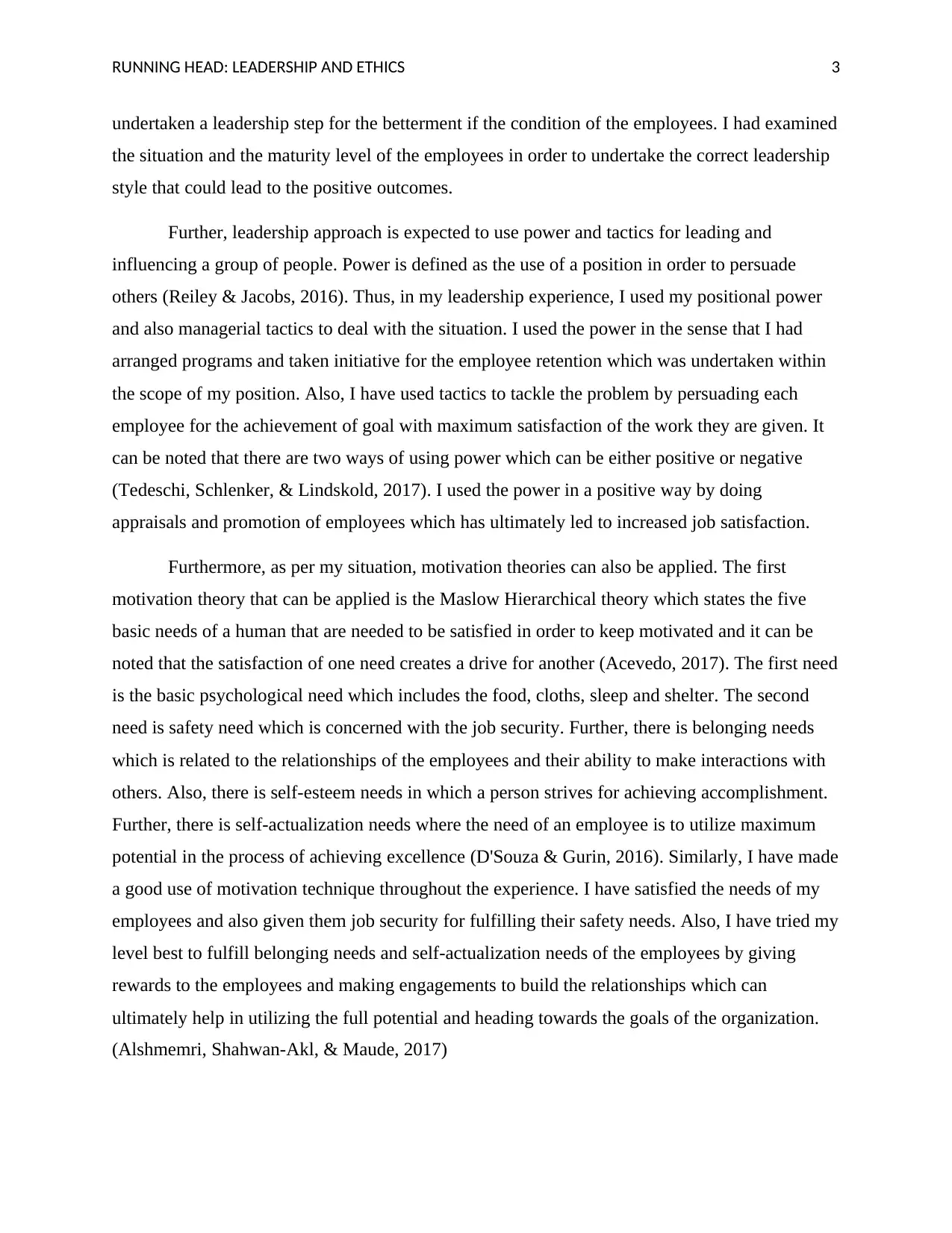
RUNNING HEAD: LEADERSHIP AND ETHICS 3
undertaken a leadership step for the betterment if the condition of the employees. I had examined
the situation and the maturity level of the employees in order to undertake the correct leadership
style that could lead to the positive outcomes.
Further, leadership approach is expected to use power and tactics for leading and
influencing a group of people. Power is defined as the use of a position in order to persuade
others (Reiley & Jacobs, 2016). Thus, in my leadership experience, I used my positional power
and also managerial tactics to deal with the situation. I used the power in the sense that I had
arranged programs and taken initiative for the employee retention which was undertaken within
the scope of my position. Also, I have used tactics to tackle the problem by persuading each
employee for the achievement of goal with maximum satisfaction of the work they are given. It
can be noted that there are two ways of using power which can be either positive or negative
(Tedeschi, Schlenker, & Lindskold, 2017). I used the power in a positive way by doing
appraisals and promotion of employees which has ultimately led to increased job satisfaction.
Furthermore, as per my situation, motivation theories can also be applied. The first
motivation theory that can be applied is the Maslow Hierarchical theory which states the five
basic needs of a human that are needed to be satisfied in order to keep motivated and it can be
noted that the satisfaction of one need creates a drive for another (Acevedo, 2017). The first need
is the basic psychological need which includes the food, cloths, sleep and shelter. The second
need is safety need which is concerned with the job security. Further, there is belonging needs
which is related to the relationships of the employees and their ability to make interactions with
others. Also, there is self-esteem needs in which a person strives for achieving accomplishment.
Further, there is self-actualization needs where the need of an employee is to utilize maximum
potential in the process of achieving excellence (D'Souza & Gurin, 2016). Similarly, I have made
a good use of motivation technique throughout the experience. I have satisfied the needs of my
employees and also given them job security for fulfilling their safety needs. Also, I have tried my
level best to fulfill belonging needs and self-actualization needs of the employees by giving
rewards to the employees and making engagements to build the relationships which can
ultimately help in utilizing the full potential and heading towards the goals of the organization.
(Alshmemri, Shahwan-Akl, & Maude, 2017)
undertaken a leadership step for the betterment if the condition of the employees. I had examined
the situation and the maturity level of the employees in order to undertake the correct leadership
style that could lead to the positive outcomes.
Further, leadership approach is expected to use power and tactics for leading and
influencing a group of people. Power is defined as the use of a position in order to persuade
others (Reiley & Jacobs, 2016). Thus, in my leadership experience, I used my positional power
and also managerial tactics to deal with the situation. I used the power in the sense that I had
arranged programs and taken initiative for the employee retention which was undertaken within
the scope of my position. Also, I have used tactics to tackle the problem by persuading each
employee for the achievement of goal with maximum satisfaction of the work they are given. It
can be noted that there are two ways of using power which can be either positive or negative
(Tedeschi, Schlenker, & Lindskold, 2017). I used the power in a positive way by doing
appraisals and promotion of employees which has ultimately led to increased job satisfaction.
Furthermore, as per my situation, motivation theories can also be applied. The first
motivation theory that can be applied is the Maslow Hierarchical theory which states the five
basic needs of a human that are needed to be satisfied in order to keep motivated and it can be
noted that the satisfaction of one need creates a drive for another (Acevedo, 2017). The first need
is the basic psychological need which includes the food, cloths, sleep and shelter. The second
need is safety need which is concerned with the job security. Further, there is belonging needs
which is related to the relationships of the employees and their ability to make interactions with
others. Also, there is self-esteem needs in which a person strives for achieving accomplishment.
Further, there is self-actualization needs where the need of an employee is to utilize maximum
potential in the process of achieving excellence (D'Souza & Gurin, 2016). Similarly, I have made
a good use of motivation technique throughout the experience. I have satisfied the needs of my
employees and also given them job security for fulfilling their safety needs. Also, I have tried my
level best to fulfill belonging needs and self-actualization needs of the employees by giving
rewards to the employees and making engagements to build the relationships which can
ultimately help in utilizing the full potential and heading towards the goals of the organization.
(Alshmemri, Shahwan-Akl, & Maude, 2017)
Paraphrase This Document
Need a fresh take? Get an instant paraphrase of this document with our AI Paraphraser
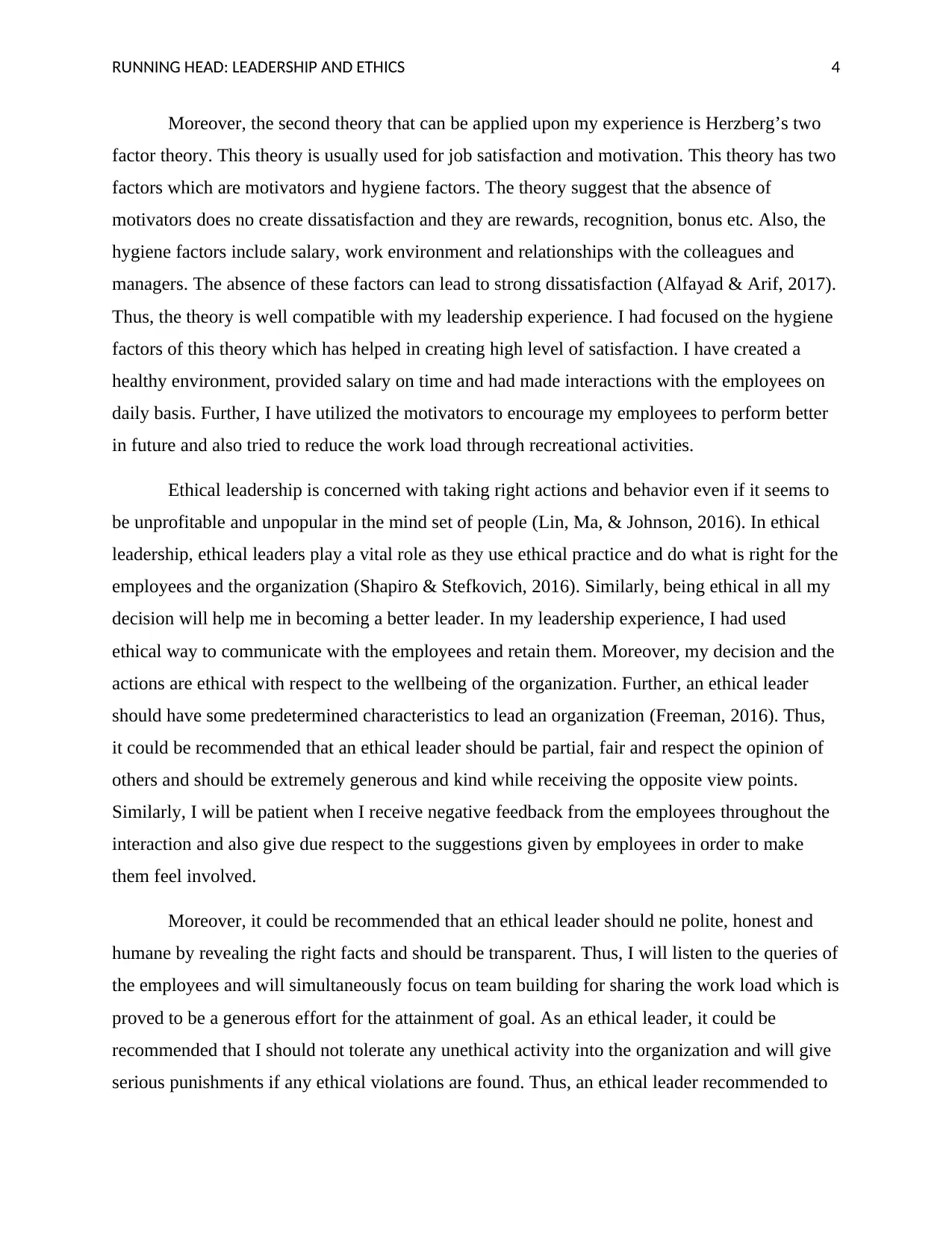
RUNNING HEAD: LEADERSHIP AND ETHICS 4
Moreover, the second theory that can be applied upon my experience is Herzberg’s two
factor theory. This theory is usually used for job satisfaction and motivation. This theory has two
factors which are motivators and hygiene factors. The theory suggest that the absence of
motivators does no create dissatisfaction and they are rewards, recognition, bonus etc. Also, the
hygiene factors include salary, work environment and relationships with the colleagues and
managers. The absence of these factors can lead to strong dissatisfaction (Alfayad & Arif, 2017).
Thus, the theory is well compatible with my leadership experience. I had focused on the hygiene
factors of this theory which has helped in creating high level of satisfaction. I have created a
healthy environment, provided salary on time and had made interactions with the employees on
daily basis. Further, I have utilized the motivators to encourage my employees to perform better
in future and also tried to reduce the work load through recreational activities.
Ethical leadership is concerned with taking right actions and behavior even if it seems to
be unprofitable and unpopular in the mind set of people (Lin, Ma, & Johnson, 2016). In ethical
leadership, ethical leaders play a vital role as they use ethical practice and do what is right for the
employees and the organization (Shapiro & Stefkovich, 2016). Similarly, being ethical in all my
decision will help me in becoming a better leader. In my leadership experience, I had used
ethical way to communicate with the employees and retain them. Moreover, my decision and the
actions are ethical with respect to the wellbeing of the organization. Further, an ethical leader
should have some predetermined characteristics to lead an organization (Freeman, 2016). Thus,
it could be recommended that an ethical leader should be partial, fair and respect the opinion of
others and should be extremely generous and kind while receiving the opposite view points.
Similarly, I will be patient when I receive negative feedback from the employees throughout the
interaction and also give due respect to the suggestions given by employees in order to make
them feel involved.
Moreover, it could be recommended that an ethical leader should ne polite, honest and
humane by revealing the right facts and should be transparent. Thus, I will listen to the queries of
the employees and will simultaneously focus on team building for sharing the work load which is
proved to be a generous effort for the attainment of goal. As an ethical leader, it could be
recommended that I should not tolerate any unethical activity into the organization and will give
serious punishments if any ethical violations are found. Thus, an ethical leader recommended to
Moreover, the second theory that can be applied upon my experience is Herzberg’s two
factor theory. This theory is usually used for job satisfaction and motivation. This theory has two
factors which are motivators and hygiene factors. The theory suggest that the absence of
motivators does no create dissatisfaction and they are rewards, recognition, bonus etc. Also, the
hygiene factors include salary, work environment and relationships with the colleagues and
managers. The absence of these factors can lead to strong dissatisfaction (Alfayad & Arif, 2017).
Thus, the theory is well compatible with my leadership experience. I had focused on the hygiene
factors of this theory which has helped in creating high level of satisfaction. I have created a
healthy environment, provided salary on time and had made interactions with the employees on
daily basis. Further, I have utilized the motivators to encourage my employees to perform better
in future and also tried to reduce the work load through recreational activities.
Ethical leadership is concerned with taking right actions and behavior even if it seems to
be unprofitable and unpopular in the mind set of people (Lin, Ma, & Johnson, 2016). In ethical
leadership, ethical leaders play a vital role as they use ethical practice and do what is right for the
employees and the organization (Shapiro & Stefkovich, 2016). Similarly, being ethical in all my
decision will help me in becoming a better leader. In my leadership experience, I had used
ethical way to communicate with the employees and retain them. Moreover, my decision and the
actions are ethical with respect to the wellbeing of the organization. Further, an ethical leader
should have some predetermined characteristics to lead an organization (Freeman, 2016). Thus,
it could be recommended that an ethical leader should be partial, fair and respect the opinion of
others and should be extremely generous and kind while receiving the opposite view points.
Similarly, I will be patient when I receive negative feedback from the employees throughout the
interaction and also give due respect to the suggestions given by employees in order to make
them feel involved.
Moreover, it could be recommended that an ethical leader should ne polite, honest and
humane by revealing the right facts and should be transparent. Thus, I will listen to the queries of
the employees and will simultaneously focus on team building for sharing the work load which is
proved to be a generous effort for the attainment of goal. As an ethical leader, it could be
recommended that I should not tolerate any unethical activity into the organization and will give
serious punishments if any ethical violations are found. Thus, an ethical leader recommended to
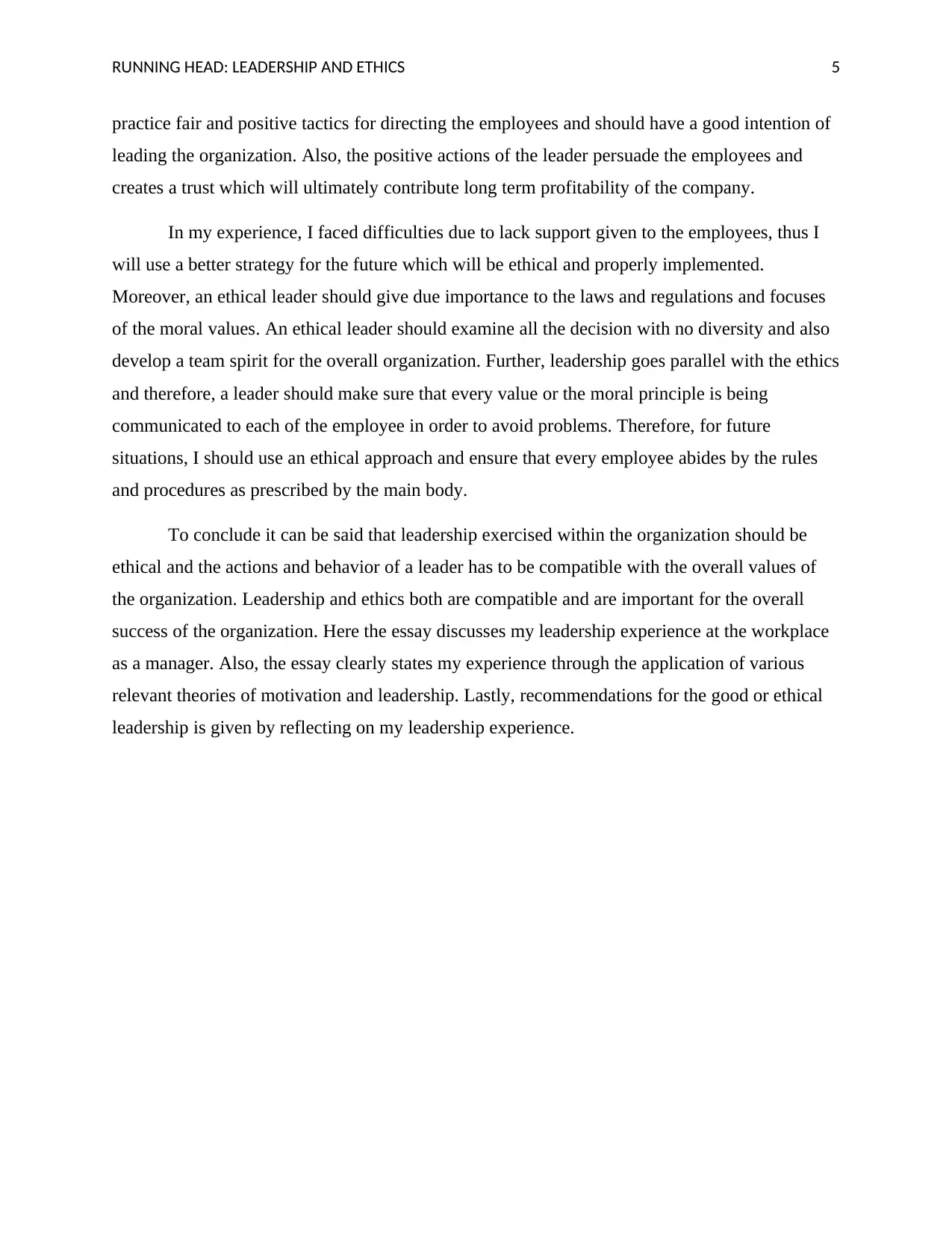
RUNNING HEAD: LEADERSHIP AND ETHICS 5
practice fair and positive tactics for directing the employees and should have a good intention of
leading the organization. Also, the positive actions of the leader persuade the employees and
creates a trust which will ultimately contribute long term profitability of the company.
In my experience, I faced difficulties due to lack support given to the employees, thus I
will use a better strategy for the future which will be ethical and properly implemented.
Moreover, an ethical leader should give due importance to the laws and regulations and focuses
of the moral values. An ethical leader should examine all the decision with no diversity and also
develop a team spirit for the overall organization. Further, leadership goes parallel with the ethics
and therefore, a leader should make sure that every value or the moral principle is being
communicated to each of the employee in order to avoid problems. Therefore, for future
situations, I should use an ethical approach and ensure that every employee abides by the rules
and procedures as prescribed by the main body.
To conclude it can be said that leadership exercised within the organization should be
ethical and the actions and behavior of a leader has to be compatible with the overall values of
the organization. Leadership and ethics both are compatible and are important for the overall
success of the organization. Here the essay discusses my leadership experience at the workplace
as a manager. Also, the essay clearly states my experience through the application of various
relevant theories of motivation and leadership. Lastly, recommendations for the good or ethical
leadership is given by reflecting on my leadership experience.
practice fair and positive tactics for directing the employees and should have a good intention of
leading the organization. Also, the positive actions of the leader persuade the employees and
creates a trust which will ultimately contribute long term profitability of the company.
In my experience, I faced difficulties due to lack support given to the employees, thus I
will use a better strategy for the future which will be ethical and properly implemented.
Moreover, an ethical leader should give due importance to the laws and regulations and focuses
of the moral values. An ethical leader should examine all the decision with no diversity and also
develop a team spirit for the overall organization. Further, leadership goes parallel with the ethics
and therefore, a leader should make sure that every value or the moral principle is being
communicated to each of the employee in order to avoid problems. Therefore, for future
situations, I should use an ethical approach and ensure that every employee abides by the rules
and procedures as prescribed by the main body.
To conclude it can be said that leadership exercised within the organization should be
ethical and the actions and behavior of a leader has to be compatible with the overall values of
the organization. Leadership and ethics both are compatible and are important for the overall
success of the organization. Here the essay discusses my leadership experience at the workplace
as a manager. Also, the essay clearly states my experience through the application of various
relevant theories of motivation and leadership. Lastly, recommendations for the good or ethical
leadership is given by reflecting on my leadership experience.
⊘ This is a preview!⊘
Do you want full access?
Subscribe today to unlock all pages.

Trusted by 1+ million students worldwide
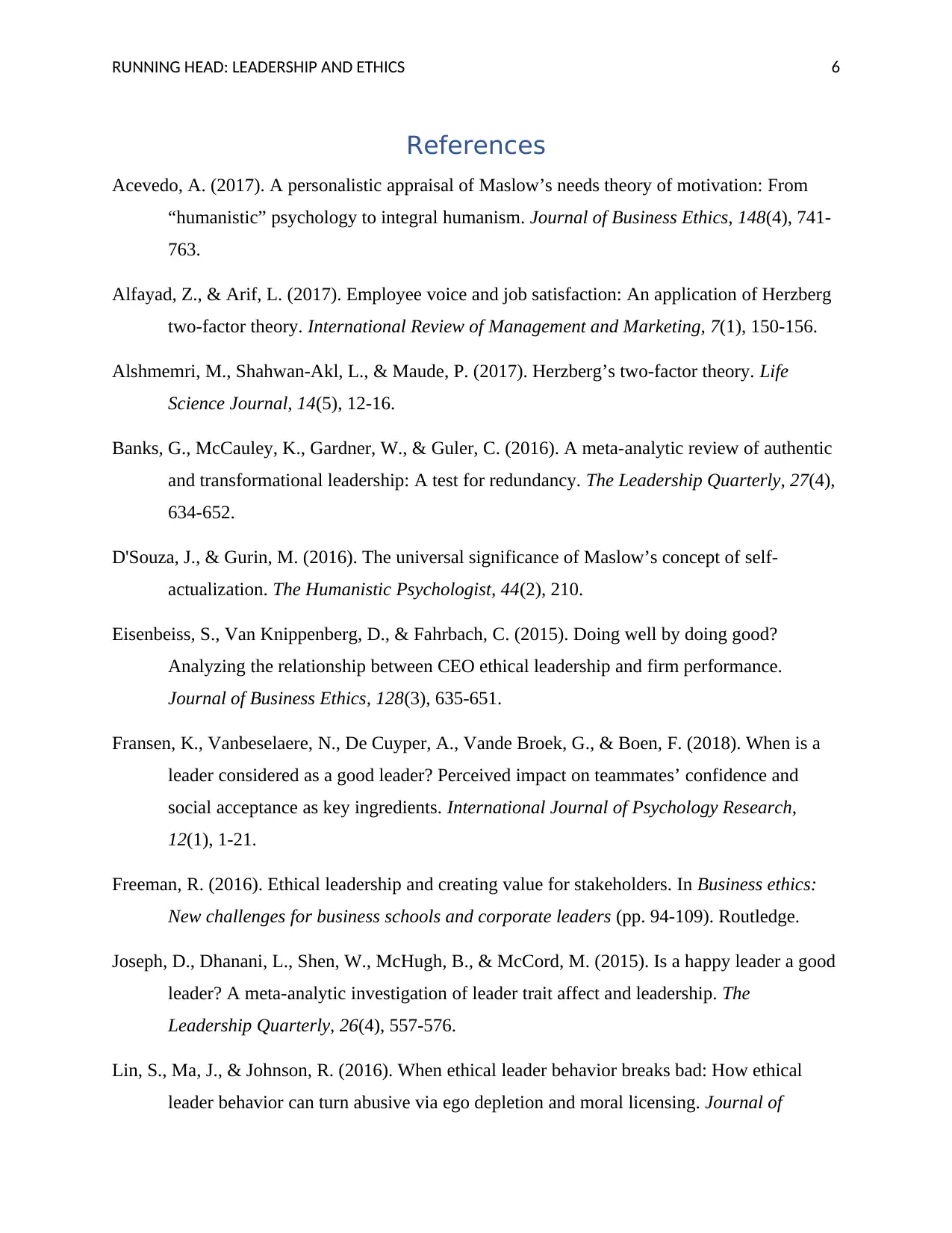
RUNNING HEAD: LEADERSHIP AND ETHICS 6
References
Acevedo, A. (2017). A personalistic appraisal of Maslow’s needs theory of motivation: From
“humanistic” psychology to integral humanism. Journal of Business Ethics, 148(4), 741-
763.
Alfayad, Z., & Arif, L. (2017). Employee voice and job satisfaction: An application of Herzberg
two-factor theory. International Review of Management and Marketing, 7(1), 150-156.
Alshmemri, M., Shahwan-Akl, L., & Maude, P. (2017). Herzberg’s two-factor theory. Life
Science Journal, 14(5), 12-16.
Banks, G., McCauley, K., Gardner, W., & Guler, C. (2016). A meta-analytic review of authentic
and transformational leadership: A test for redundancy. The Leadership Quarterly, 27(4),
634-652.
D'Souza, J., & Gurin, M. (2016). The universal significance of Maslow’s concept of self-
actualization. The Humanistic Psychologist, 44(2), 210.
Eisenbeiss, S., Van Knippenberg, D., & Fahrbach, C. (2015). Doing well by doing good?
Analyzing the relationship between CEO ethical leadership and firm performance.
Journal of Business Ethics, 128(3), 635-651.
Fransen, K., Vanbeselaere, N., De Cuyper, A., Vande Broek, G., & Boen, F. (2018). When is a
leader considered as a good leader? Perceived impact on teammates’ confidence and
social acceptance as key ingredients. International Journal of Psychology Research,
12(1), 1-21.
Freeman, R. (2016). Ethical leadership and creating value for stakeholders. In Business ethics:
New challenges for business schools and corporate leaders (pp. 94-109). Routledge.
Joseph, D., Dhanani, L., Shen, W., McHugh, B., & McCord, M. (2015). Is a happy leader a good
leader? A meta-analytic investigation of leader trait affect and leadership. The
Leadership Quarterly, 26(4), 557-576.
Lin, S., Ma, J., & Johnson, R. (2016). When ethical leader behavior breaks bad: How ethical
leader behavior can turn abusive via ego depletion and moral licensing. Journal of
References
Acevedo, A. (2017). A personalistic appraisal of Maslow’s needs theory of motivation: From
“humanistic” psychology to integral humanism. Journal of Business Ethics, 148(4), 741-
763.
Alfayad, Z., & Arif, L. (2017). Employee voice and job satisfaction: An application of Herzberg
two-factor theory. International Review of Management and Marketing, 7(1), 150-156.
Alshmemri, M., Shahwan-Akl, L., & Maude, P. (2017). Herzberg’s two-factor theory. Life
Science Journal, 14(5), 12-16.
Banks, G., McCauley, K., Gardner, W., & Guler, C. (2016). A meta-analytic review of authentic
and transformational leadership: A test for redundancy. The Leadership Quarterly, 27(4),
634-652.
D'Souza, J., & Gurin, M. (2016). The universal significance of Maslow’s concept of self-
actualization. The Humanistic Psychologist, 44(2), 210.
Eisenbeiss, S., Van Knippenberg, D., & Fahrbach, C. (2015). Doing well by doing good?
Analyzing the relationship between CEO ethical leadership and firm performance.
Journal of Business Ethics, 128(3), 635-651.
Fransen, K., Vanbeselaere, N., De Cuyper, A., Vande Broek, G., & Boen, F. (2018). When is a
leader considered as a good leader? Perceived impact on teammates’ confidence and
social acceptance as key ingredients. International Journal of Psychology Research,
12(1), 1-21.
Freeman, R. (2016). Ethical leadership and creating value for stakeholders. In Business ethics:
New challenges for business schools and corporate leaders (pp. 94-109). Routledge.
Joseph, D., Dhanani, L., Shen, W., McHugh, B., & McCord, M. (2015). Is a happy leader a good
leader? A meta-analytic investigation of leader trait affect and leadership. The
Leadership Quarterly, 26(4), 557-576.
Lin, S., Ma, J., & Johnson, R. (2016). When ethical leader behavior breaks bad: How ethical
leader behavior can turn abusive via ego depletion and moral licensing. Journal of
Paraphrase This Document
Need a fresh take? Get an instant paraphrase of this document with our AI Paraphraser
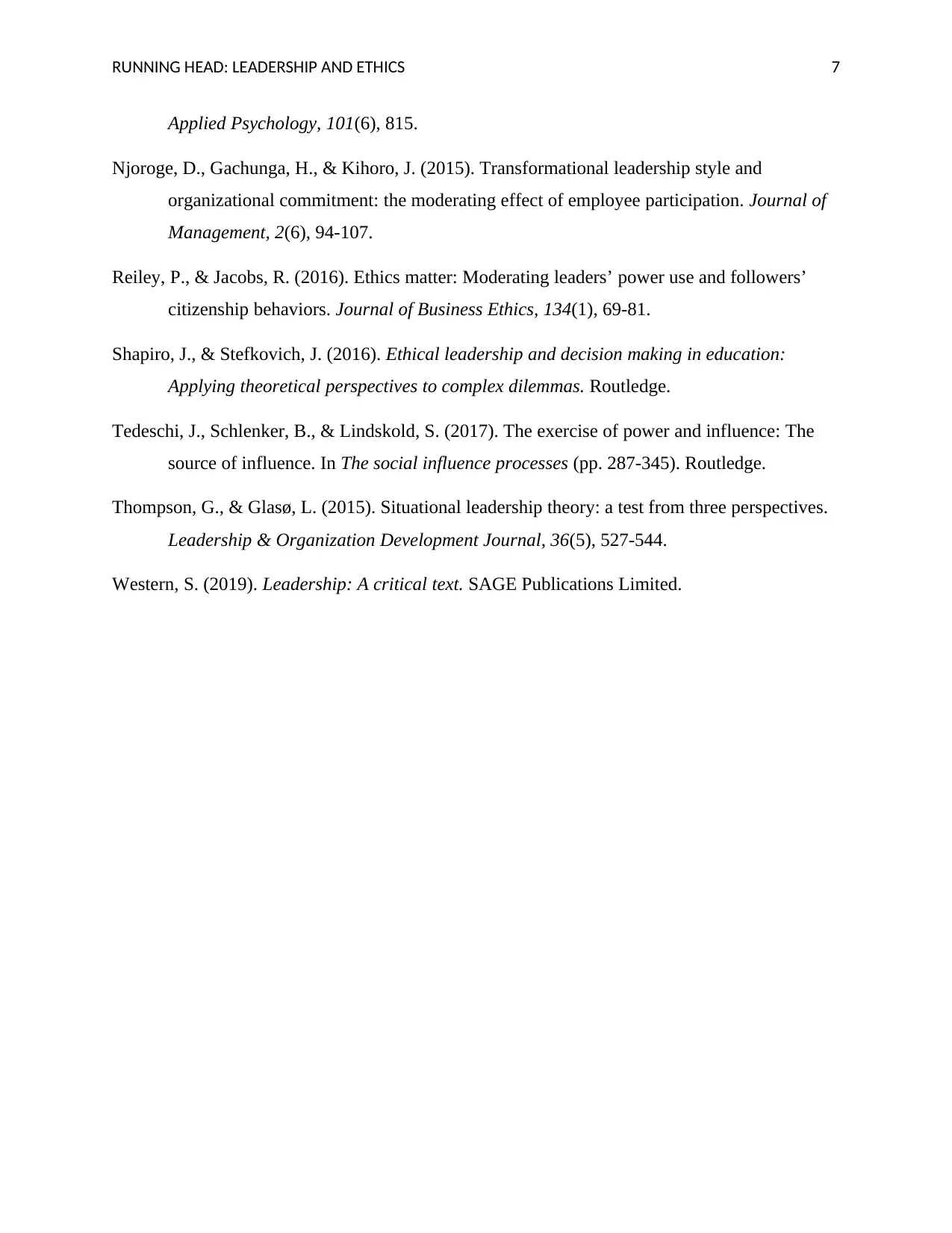
RUNNING HEAD: LEADERSHIP AND ETHICS 7
Applied Psychology, 101(6), 815.
Njoroge, D., Gachunga, H., & Kihoro, J. (2015). Transformational leadership style and
organizational commitment: the moderating effect of employee participation. Journal of
Management, 2(6), 94-107.
Reiley, P., & Jacobs, R. (2016). Ethics matter: Moderating leaders’ power use and followers’
citizenship behaviors. Journal of Business Ethics, 134(1), 69-81.
Shapiro, J., & Stefkovich, J. (2016). Ethical leadership and decision making in education:
Applying theoretical perspectives to complex dilemmas. Routledge.
Tedeschi, J., Schlenker, B., & Lindskold, S. (2017). The exercise of power and influence: The
source of influence. In The social influence processes (pp. 287-345). Routledge.
Thompson, G., & Glasø, L. (2015). Situational leadership theory: a test from three perspectives.
Leadership & Organization Development Journal, 36(5), 527-544.
Western, S. (2019). Leadership: A critical text. SAGE Publications Limited.
Applied Psychology, 101(6), 815.
Njoroge, D., Gachunga, H., & Kihoro, J. (2015). Transformational leadership style and
organizational commitment: the moderating effect of employee participation. Journal of
Management, 2(6), 94-107.
Reiley, P., & Jacobs, R. (2016). Ethics matter: Moderating leaders’ power use and followers’
citizenship behaviors. Journal of Business Ethics, 134(1), 69-81.
Shapiro, J., & Stefkovich, J. (2016). Ethical leadership and decision making in education:
Applying theoretical perspectives to complex dilemmas. Routledge.
Tedeschi, J., Schlenker, B., & Lindskold, S. (2017). The exercise of power and influence: The
source of influence. In The social influence processes (pp. 287-345). Routledge.
Thompson, G., & Glasø, L. (2015). Situational leadership theory: a test from three perspectives.
Leadership & Organization Development Journal, 36(5), 527-544.
Western, S. (2019). Leadership: A critical text. SAGE Publications Limited.
1 out of 8
Related Documents
Your All-in-One AI-Powered Toolkit for Academic Success.
+13062052269
info@desklib.com
Available 24*7 on WhatsApp / Email
![[object Object]](/_next/static/media/star-bottom.7253800d.svg)
Unlock your academic potential
Copyright © 2020–2025 A2Z Services. All Rights Reserved. Developed and managed by ZUCOL.




